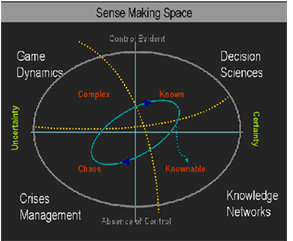 Strategic decision making is probably the most important process of corporate life and deserves to have a structured design. This process establishes one of the main value propositions of Fifth Thinking. Our concept defines an game-driven organization around five capabilities: a) Networks of people spread across the business b) Business ecosystem scanning c) Opportunities for these networks to connect and dialogue using this information d) The envisaging of critical information in ways that allows us to “see” through the game complexity, leveraging capabilities and resources appropriately e) The means to make shared meaning from and to act on this intelligence. Strategic decision making is probably the most important process of corporate life and deserves to have a structured design. This process establishes one of the main value propositions of Fifth Thinking. Our concept defines an game-driven organization around five capabilities: a) Networks of people spread across the business b) Business ecosystem scanning c) Opportunities for these networks to connect and dialogue using this information d) The envisaging of critical information in ways that allows us to “see” through the game complexity, leveraging capabilities and resources appropriately e) The means to make shared meaning from and to act on this intelligence.
These capabilities are arranged in four linked pairs, each pair representing one type of learning domain (sensing, sense making, designing, and actioning). Although each discrete phase has its own sub processes and associated tools and techniques, they also point forwards (in development) and backwards in time (in appraising and reviewing). Each learning domain in the processhas a product (or output) that acts much like a propulsion agent as it inputs into the next phase. We call these four sets of combined inputs and outputs “transition systems.” These transition systems either provoke the collection and integration of useful information from a variety of sources into the ongoing process of knowledge creation or, enrich our capacity for actioning change.
The complete game analysis process facilitates the fundamental pattern and criteria of any complex adaptive (learning) system; namely, that it:
- Acquires intelligence about the competitive game,
- Acquires intelligence about its own interaction with the game,
- Identifies (ir)regularities in that intelligence,
- Condenses regularities into a complex dynamic model,
- Acts and monitors in the real world accordingly ,
- Qualifies competing models vs. real world results,
- Upgrades its models based on emerging business realities.
The most significant aspect of the model lies in its last phase, which, in fact, is the predecessor to moving through the higher order of awareness. This coevolving phase entails being responsive to the effects of your actions. The information that comes from these transactions is analyzed and then fed into the contextualizing phase as intelligence, thereby moving us into an iteration of the learning process at different levels where we are able to focus on the process of learning and the nature of knowledge itself.
The strategic learning enables far greater levels of consciousness about ourselves as well as our relationship to the business game of which we are a part. The real value of our processes, therefore, resides in this intrinsic development of consciousness through processes of mapping and strategic conversation. It integrates multiple perspectives into our thinking; generates dialogue; and effectively maps the changing dynamics of our game, allowing us to make more informed and insightful decisions for change. It is the continuous building of intelligence and learning from which planning and strategic learning emerges.
In our sense, strategy is a distributed consciousness which is developed and executed by a critical mass of people though a structured conversation, analysis and modeling process. |